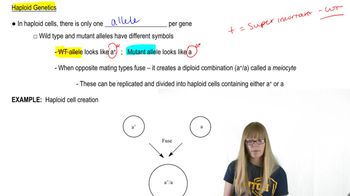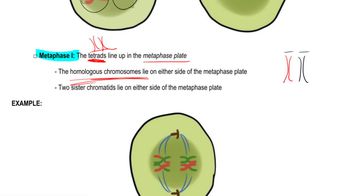Table of contents
- 1. Introduction to Genetics51m
- 2. Mendel's Laws of Inheritance3h 37m
- 3. Extensions to Mendelian Inheritance2h 41m
- 4. Genetic Mapping and Linkage2h 28m
- 5. Genetics of Bacteria and Viruses1h 21m
- 6. Chromosomal Variation1h 48m
- 7. DNA and Chromosome Structure56m
- 8. DNA Replication1h 10m
- 9. Mitosis and Meiosis1h 34m
- 10. Transcription1h 0m
- 11. Translation58m
- 12. Gene Regulation in Prokaryotes1h 19m
- 13. Gene Regulation in Eukaryotes44m
- 14. Genetic Control of Development44m
- 15. Genomes and Genomics1h 50m
- 16. Transposable Elements47m
- 17. Mutation, Repair, and Recombination1h 6m
- 18. Molecular Genetic Tools19m
- 19. Cancer Genetics29m
- 20. Quantitative Genetics1h 26m
- 21. Population Genetics50m
- 22. Evolutionary Genetics29m
17. Mutation, Repair, and Recombination
Induced Mutations
Problem 29a
Textbook Question
Textbook QuestionA wild-type culture of haploid yeast is exposed to ethyl methanesulfonate (EMS). Yeast cells are plated on a complete medium, and 6 colonies (colonies numbered 1 to 6) are transferred to a new complete medium plate for further study. Four replica plates are made from the complete medium plate to plates containing minimal medium or minimal medium plus one amino acid4 (replica plates numbered 1 to 4) with the following results: Are there any colonies for which genotype information cannot be determined? If so, which colony or colonies?
 Verified Solution
Verified SolutionThis video solution was recommended by our tutors as helpful for the problem above
Video duration:
1mPlay a video:
Was this helpful?
Key Concepts
Here are the essential concepts you must grasp in order to answer the question correctly.
Haploid Organisms
Haploid organisms, like yeast, have a single set of chromosomes, which means they possess only one allele for each gene. This simplifies genetic analysis since any mutation will directly affect the phenotype. In the context of the question, understanding haploidy is crucial for determining how mutations induced by EMS may manifest in the yeast colonies.
Recommended video:
Guided course

Haploid Genetics
Mutagenesis
Mutagenesis refers to the process by which the genetic information of an organism is changed, resulting in mutations. Ethyl methanesulfonate (EMS) is a chemical mutagen that can induce point mutations in DNA. Recognizing how EMS affects yeast genetics is essential for interpreting the results of the experiment and understanding which colonies may exhibit unknown genotypes.
Recommended video:
Guided course

Induced Mutations
Replica Plating
Replica plating is a technique used to transfer colonies from one agar plate to another, allowing for the assessment of growth under different conditions. In this experiment, colonies are transferred to minimal medium to test for auxotrophy, which indicates whether they can synthesize certain amino acids. This method is key to determining if any colonies have unknown genotypes based on their growth patterns in the presence or absence of specific nutrients.
Recommended video:
Guided course

Meiosis Steps

 4:29m
4:29mWatch next
Master Induced Mutations with a bite sized video explanation from Kylia Goodner
Start learningRelated Videos
Related Practice

